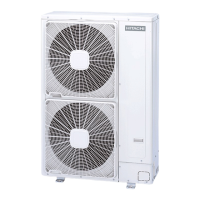8 Troubleshooting
313
SMGB0087 rev.0 - 12/2013
8
Checking procedure for the reversing valve
Troubleshooting
Is the connector PCN(6/100) *1)
on PCB1 connected correctly?
Is there output voltage *3)
generated from the connector
PCN(6/100 )*1) on PCB1?
Is the resistance of the reversing
valve coil *2) correct?
Reversing valve is faulty (valve lock-
ing, etc.). Replace it with a new one.
Yes
No
No
No
Yes
Yes
Connect it correctly.
Reversing valve is faulty (disconnec-
tion, etc.). Replace it with a new one.
PCB1 is faulty (Faulty reversing
valve circuit, etc.). Replace it with a
new one.
N O T E
*1) PCB1 connnector PCN100 (PCN6
RAS-(2-2.5)HVNP1, RAS-3HVNC1
ANDRAS-(4-6)H(V)NC1E), pin 1 - 3
*2) See in the table “Resistance (Ω)”
*3) See in the table”Output voltage” ac-
cording to coil type operation mode.
Output voltage
Reversing valve ON Reversing valve OFF
N O T E
The values may differ depending on testers.
Appropriate output voltage is 70~339VDC
Test lead (+side) pin 1 pin 3
Test lead (-side) pin 3 pin 1
Range of voltaje 325 VDC 163 VDC
Actions of 4-way solenoid valve
Monostable solenoid operation type
Operation Mode: Heating Reversing Valve Coil: ON Operation Mode: Cooling Reversing Valve Coil: OFF
Electric Current Applied
Current is applied to the reversing valve coil and so attraction is
generated. The plunger position is kept by the electromagnetic
force.
No Electric Current Applied
No current is applied to the reversing valve coil and so no attrac-
tion is generated. The plunger position is kept by spring force.
Coil
Attractor
Plunger
Plunger position
Coil case
Magnetic
screw
Spring force
Electromagnetic force (Posi-
tion keeping force)
Coil
Attractor
Plunger
Plunger position
Coil case
Spring force
(Position keeping force)
Electromagnetic force = 0
Magnetic
screw
Electrical circuit

